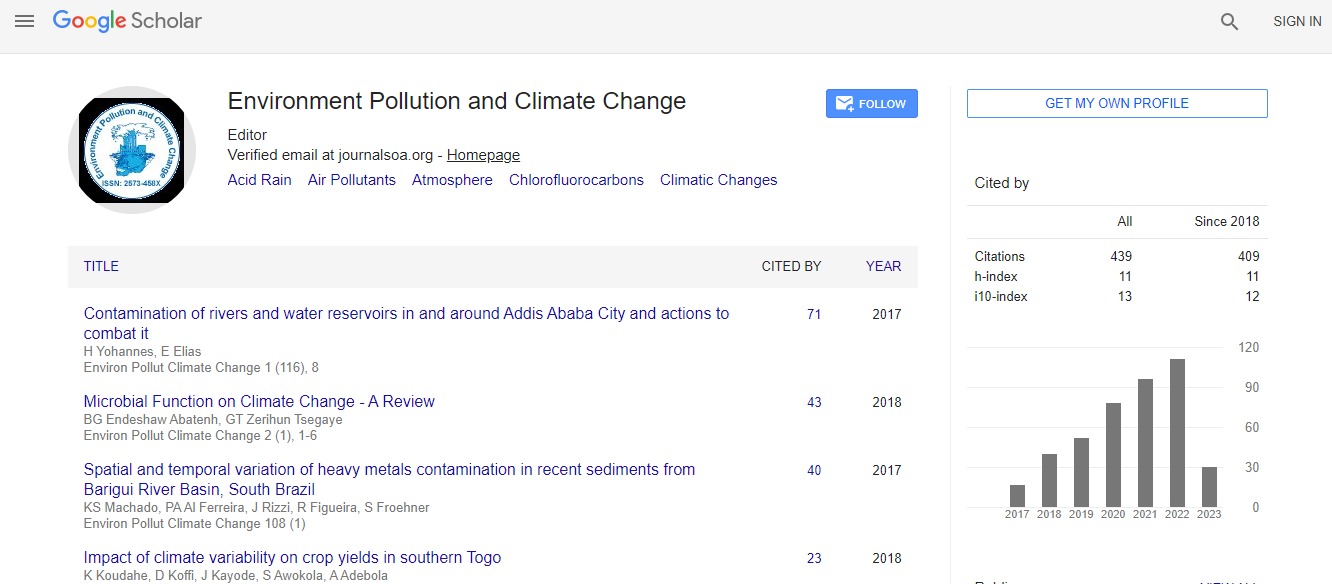Our Group organises 3000+ Global Conferenceseries Events every year across USA, Europe & Asia with support from 1000 more scientific Societies and Publishes 700+ Open Access Journals which contains over 50000 eminent personalities, reputed scientists as editorial board members.
Open Access Journals gaining more Readers and Citations
700 Journals and 15,000,000 Readers Each Journal is getting 25,000+ Readers
Google Scholar citation report
Citations : 672
Environment Pollution and Climate Change received 672 citations as per Google Scholar report
Environment Pollution and Climate Change peer review process verified at publons
Indexed In
- Google Scholar
- Publons
- Euro Pub
- ICMJE
Useful Links
Recommended Journals
Share This Page
Effects of aluminium salts and cyclic volatile methylsiloxanes on DNA damage and DNA repair in immortalized non-transformed human breast epithelial cells
Joint Event on 5th World Conference on Climate Change & 16th Annual Meeting on Environmental Toxicology and Biological Systems
Abdullah Mohammed O Farasani and Darbre P D
Jazan University, Saudi ArabiaUniversity of Reading, UK
ScientificTracks Abstracts: Environ Pollut Climate Change
Abstract
Dermal absorption of components of underarm cosmetics may be a contributory factor in breast cancer development. Aluminium (Al) salts are added as the active antiperspirant agent, and cyclic volatile methylsiloxanes (cVMS) are used for purposes of conditioning and spreading. Al has been measured in human breast tissue, breast cyst fluid, nipple aspirate fluid and milk: Al levels in breast tissue have been recently reported to be a risk factor for breast cancer in young women. cVMS have been measured in human milk. The objectives of this study were to investigate any genotoxic effects of exposure to the antiperspirant salts Al chloride and Al chlorohydrate, and to the cVMS hexamethylcyclotrisiloxane (D3), octamethylcyclotetrasiloxane (D4) and decamethylcyclopentasiloxane (D5) in immortalized non-transformed human breast epithelial cells. All these compounds enabled a dose-dependent growth of the non-transformed cells in suspension culture, which is an established marker of transformation. DNA damage was demonstrated using a comet assay. Long term (≥20 weeks) exposure to these compounds also resulted in loss of expression (mRNA and protein) of the breast cancer susceptibility gene BRCA1 which is a key gene in the repair of DNA in breast cells. Alterations to expression of other DNA repair genes at an mRNA level will be presented. If these compounds can both damage DNA and compromise DNA repair systems, then there is the potential for breast carcinogenesis. Recent Publications 1. A and Darbre P D (2017) Exposure to cyclic volatile methylsiloxanes (cVMS) causes anchorage-independent growth and reduction of BRCA1 in non-transformed human breast epithelial cells. Journal of Applied Toxicology 37(4):454–461. 2. Farasani A (2017) Importance of exome sequencing in the human diseases and medical genetics. J Genet Genomic Sci. 2:006. 3. Farasani A and Darbre P D (2015) Effect of aluminium chloride and aluminium chlorohydrate on DNA repair processes in MCF10A immortalized non-transformed human breast epithelial cells. Journal of Inorganic Biochemistry 152(2015):186–9.Biography
Abdullah Mohammed O Farasani received his PhD from Reading University, UK in 2016 for his work on genotoxicity of cosmetic chemicals in human breast epithelial cells. He is currently working as the head of Genetic Unit in the MLT Department at Jazan University, Saudi Arabia.
E-mail: farasani@hotmail.co.uk

 Spanish
Spanish  Chinese
Chinese  Russian
Russian  German
German  French
French  Japanese
Japanese  Portuguese
Portuguese  Hindi
Hindi 
